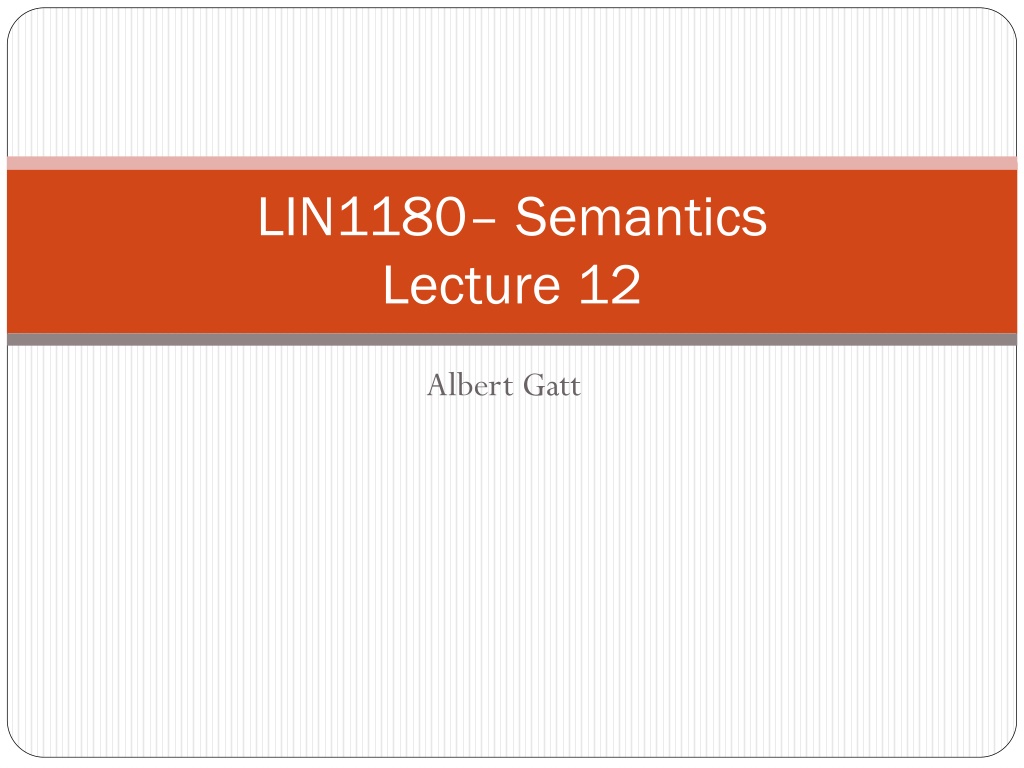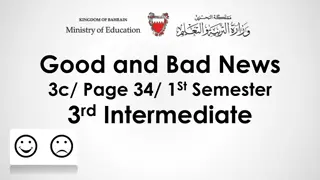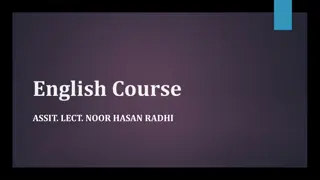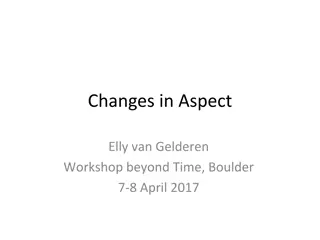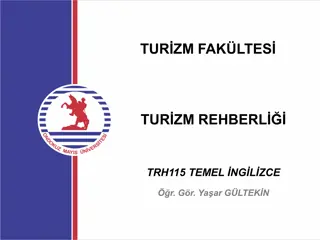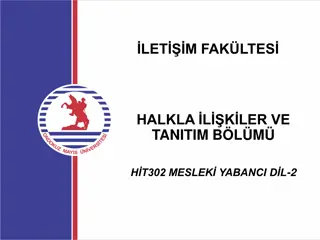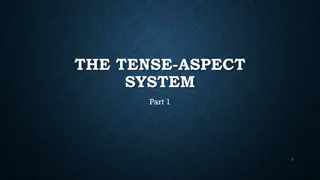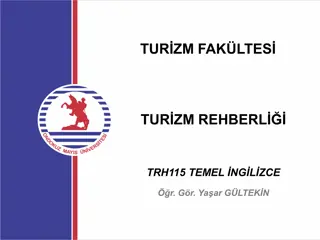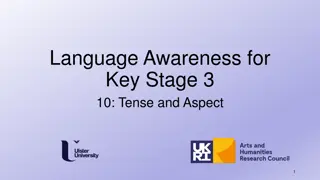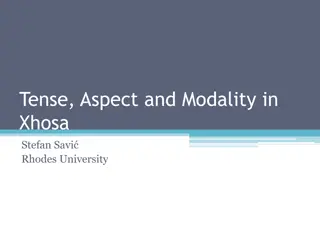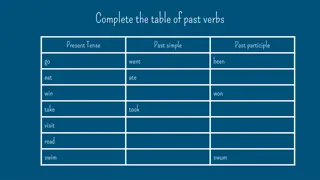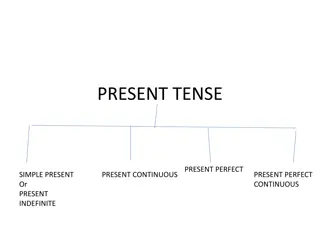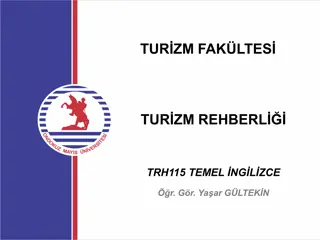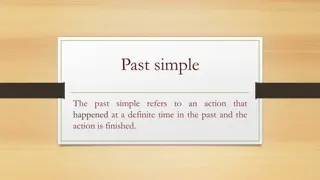Understanding Tense and Grammatical Aspect in Language
This lecture delves into the intricacies of tense and grammatical aspect, exploring concepts such as progressive/non-progressive, perfective/imperfective aspects across languages. It discusses the interaction between grammatical aspect and lexical aspect (Aktionsart), focusing on tense as a deictic system and the classic distinctions of past, present, and future. The graphical characterization of time, tense variations in English and Maltese languages, and the distinction between tense and grammatical aspect are also covered.
Download Presentation

Please find below an Image/Link to download the presentation.
The content on the website is provided AS IS for your information and personal use only. It may not be sold, licensed, or shared on other websites without obtaining consent from the author. Download presentation by click this link. If you encounter any issues during the download, it is possible that the publisher has removed the file from their server.
E N D
Presentation Transcript
LIN1180 Semantics Lecture 12 Albert Gatt
In this lecture We focus on tense and grammatical aspect Progressive/non-progressive Perfective/imperfective Aspect across languages Interaction of grammatical aspect and lexical aspect (Aktionsart)
Part 1 Tense as a deictic system
A general characterisation of deixis Deictic expressions rely on the context of utterance deictic demonstrative pronouns: this, that, those deictic place expressions: here, there Relevant features of the context: physical context persons involved in communication time
Tense as deictic Classic distinction between: past present future Relies on the relationship in time between the event talked about and the time of utterance therefore, the reference point is usually the act of speaking
Graphical characterisation past future present time of utterance I saw the moon. I was seeing the moon. I see the moon. I am seeing the moon. I will see the moon. I will be seeing the moon.
Tense across languages English: usually marks tense using auxiliary verbs I see I am seeing I will be seeing Maltese: can mark temporal distinctions on the main verb nara (I see), rajt (I saw) uses particles for fine-grained temporal distinctions se nara (I am going to see)
Tense vs grammatical aspect Progressive aspect: I listen (non-progressive) I am listening (progressive) Note: tense is distinct from grammatical aspect! Both examples are in the present tense. Past/Present/Future rely on the relationship between the time of an event and the moment of speaking.
Perfect We can often locate an event in the present/past/future, and use it as a reference point for another event. When you called, I had finished my work. Main reference point: now, moment of speaking Two events: you called and I had finished my work Relationship to moment of speaking: Both in the past. Relationship to eachother: Within the past time, one occurs before the other.
When you called, I had finished my work past (yesterday evening) finish work future present time of utterance you called time of finish work acts as reference for you called main reference point for past tense is the time of utterance
Perfect aspect in English Emphasises temporal relationship to a secondary reference point Present perfect: I have eaten the event of eating has terminated by the time of speaking Past perfect: I had eaten (before I left) event of eating has terminated by the time of leaving time of leaving is related to the time of speaking using the past Future perfect: I will have eaten (by the time you arrive) event of eating will terminate by the time something else happens secondary event is related to the time of speaking in the future
Reichenbachs theory of time Hans Reichenbach (1966): proposed a theory to account for both simple and perfect tenses System uses three different times: actual event time (E) reference time or time to which event is related (R) utterance time (= moment of speaking) (U)
Simple present past present future E = R = U Example: I sleep Reference time, utterance time and event time are the same
Simple past past present future U E = R Example: I slept E before U (therefore past) R = E (no secondary relation)
Simple future past present future U E = R Example: I will sleep E is after U (therefore future) R = E (no secondary relation)
Present perfect past present future E R = U Example: I have slept E before U (therefore, event understood as having already occurred) R = U basically relating a past event explicitly to the present
Past perfect past present future E R U Example: By the time you arrived, I had slept E before U R before U R after E relating a past event explicitly to another event that occurred after it, but also in the past
Future perfect past present future U E R Example: By the time you arrive tonight, I will have slept U before E (therefore future) U before R E before R Relating a future event explicitly to another event in the future which occurs after it
Summary Tense is deictic, and requires reference to the time of speaking to be determined. Distinction between: simple tenses perfect tenses Reichenbach s model uses three temporal parameters to describe the semantics of different tenses.
Part 2 Grammatical aspect
Tense vs Aspect Tense is about the location of an event in time. (Tense as deictic) Aspect has to do with the temporal distribution or contour of an event (Comrie, 1976). Aspect is independent of tense.
Lexical vs. grammatical aspect Lexical aspect (Aktionsart): an inherent property of the semantics of verbs (sentences) related to the type of situation under discussion cf. lectures 10 & 11 Grammatical aspect: ways of specifying the temporal contour of an event using grammatical means
Grammatical mechanisms Russian: perfective/imperfective marked inflectionally On ital He read.PAST.IMPERF He was reading a letter pis mo a letter On pro ital He read.PAST.PERF He read a letter pis mo a letter
Grammatical mechanisms Maltese perfective/imperfective marked inflectionally Qara read.3MSg.PERF He read a letter ittra. a letter Jaqra read.3MSg.IMPERF He reads a letter ittra. a letter.
Grammatical mechanisms Maltese progressive/non-progressive marked using aspectual particles Jaqra read.3MSg.IMPERF He reads a letter ittra. a letter. Qed PROG He is reading a letter jaqra read.3MSg.IMPERF ittra. a letter.
Grammatical mechanisms English: progressive/non-progressive marked inflectionally on main verb and auxiliary I went to the pub. I was going to the pub.
A preliminary classification (aspect) Perfective Imperfective
The perfective: definition The perfective aspect involves a view of a situation as a whole. I.e. it implies: a beginning a middle an end NB: viewing the situation as a whole does not imply that the event is completed (i.e. finished).
Perfective and tense Some languages restrict the application of the perfective to the past tense. suggests that the complete view is only applied retrospectively. Maltese Arabic Qara ittra. read.3MSg.PERF letter He read a letter Harbat al-bint run away.3FSg.PERF the-girl The girl ran away
Perfective and tense In many languages, perfective aspect is used with different tenses. Russian On pro ital pis mo (past, perfective) He read a letter ja ub ju tebja (future, perfective) I shall kill you
Perfectivity and duration Despite viewing the situation as a whole, the perfective is compatible with an expression of the duration of a situation. Maltese French Qrajt sag tejn s a . I read for two whole hours Il regna trente ans. He reigned for 30 years
The imperfective: definition The imperfective aspect involves an explicit reference to the internal temporal structure of a situation. It contrasts with the perfective insofar as it does not view the situation externally, as a whole.
A more complete classification (aspect) Perfective Imperfective Habitual (Continuous) Non-progressive In many languages, the same form can express more than one imperfective aspect! Progressive
The habitual aspect Views a situation as recurring indefinitely. English John works/worked here. John used to work here. Simple Past tense in English may have a habitual meaning. Simple present often used with habitual meaning. Habituality in the past can be marked explicitly with used to.
Progressive vs. non-progressive In the progressive, a situation is marked as ongoing. Again, this is independent of tense. English John read the book. (non-prog, past) John was reading the book. (prog., past) John will be reading the book. (prog., fut.)
Non/progressive vs im/perfective English does not explicitly distinguish im/perfective. But the English progressive vs. non-progressive distinction seems to correlate with the perfective/ imperfective distinction. English John read the book. (non-progressive + offers a complete view of the situation) John was reading the book. (progressive, also views the situation internally)
Non/progressive vs im/perfective Some languages distinguish im/perfective and non-/progressive more sharply. Spanish Juan lleg .(perfective) John arrived. Juan llegaba. (imperfective, non-progressive) John was arriving/used to arrive. (NB: can have progressive or habitual meaning) Juan estaba llegando. (imperfective + progressive) John was arriving. (progressive only)
Non/progressive vs im/perfective With a situation described in the perfective, continuation with the imperfective seems contradictory. Russian ?On napisal pis mo i e e pi et He wrote.PERF a letter and still writes.IMPERF it He wrote a letter and is still writing it. ego. The anomaly disappears with the use of the imperfective. Russian pis mo i e e My pisali We wrote.IMPERF a letter and still We wrote a letter and are still writing it. pi et write ego. it
Non/progressive vs im/perfective We can observe the same in English with the progressive/non-progressive forms. This is further evidence that English non-/progressive covers some of the im/perfective distinction. English ?John built a fire escape and is still building it. John was building a fire escape and is still building it.
The English progressive English progressive tends to have connotations of activity, dynamism and volition. She blinked her eyes. The dog was walking. ?She was knowing Greek. ?She was having blonde hair. Thus, it tends to be infelicitous with states.
The English progressive The progressive aspect interacts with situation type (lexical aspect). cf. the activity/accomplishment distinction With accomplishments (+telic), the progressive cancels the implication that the end state was reached. Activity Accomplishment John ran. John was running. John drew a circle. John was drawing a circle.
The imperfective in other languages In other languages, the imperfective is compatible with states. E.g. French imparfait Unlike the English progressive, it does not carry connotations of dynamism. French L air DEF-air The air smelt of jasmine. sentait smell.3SgM.PAST.IMPERF of jasmine de jasmin.
The English non-/progressive in future English uses progressive and non-progressive present for future. Regular future I will eat out tomorrow. I will play well tomorrow. Pres. progressive I m eating out tomorrow. ?I m playing well tomorrow. Simple present I leave tomorrow. ?I play well tomorrow. Simple present and progressive are only felicitous with events which imply volition, can be planned or are certain. This is in line with the connotations noted earlier for the English progressive.
